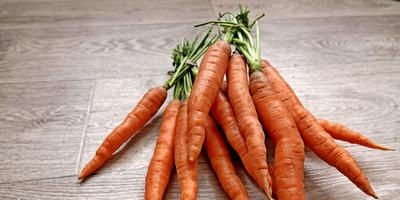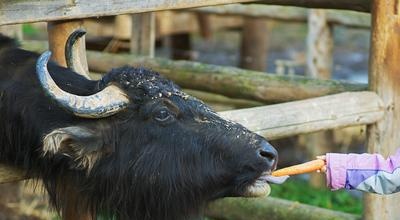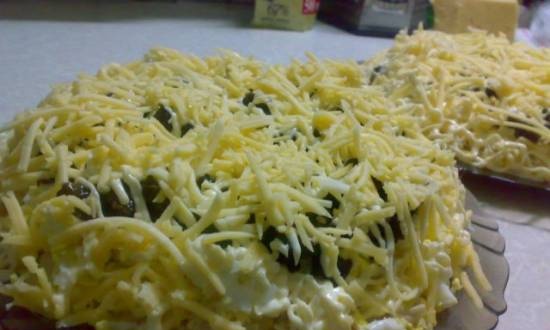|
 At the very beginning of the last century, St. Petersburg citizens were extremely surprised by the changes in the vegetable assortment. It was about carrots. Residents of the capital are used to buying short, round carotels at the market. At the very beginning of the last century, St. Petersburg citizens were extremely surprised by the changes in the vegetable assortment. It was about carrots. Residents of the capital are used to buying short, round carotels at the market.
This variety was not overly sophisticated. He did not differ in the special tenderness of the root crop and outstanding taste. But he kept up early, for which he was appreciated.
And then, quite unexpectedly, instead of the Parisian carrot, something completely different from the usual radish root crop appeared on the market. Something cylindrical appeared, similar to orange sausages. No one has ever seen such root crops. To many, they seemed disgusting, because they resembled the fingers of a human hand. The market unanimously dubbed the newly-minted carrots "semi-carrots".
 The blame for everything was the mistake of a foreign seed company, which sent seeds of the Nantskaya variety to St. Petersburg instead of the usual usual carotel. The gardener who bought the seeds was shocked when he began to harvest. The townspeople were no less puzzled afterwards. However, the gardener had the courage to taste it. The tasting calmed me a bit. The "semi-cork" turned out to be quite edible. It was even softer, juicier, and sweeter than carrot. Encouraged by this turn of affairs, the gardener handed over the harvest to the merchants. They grumbled and took the goods on the condition that it would go at the lowest price - two kopecks per bundle. Karotel at that time was ten and even twelve kopecks. At first, the buyer did not take even two kopecks. And it took quite a long time to get used to the "half-cork". And when it was appreciated, then the former glory of the carotle faded. Now she began to sell for a pittance, and Nantes went for twelve! The blame for everything was the mistake of a foreign seed company, which sent seeds of the Nantskaya variety to St. Petersburg instead of the usual usual carotel. The gardener who bought the seeds was shocked when he began to harvest. The townspeople were no less puzzled afterwards. However, the gardener had the courage to taste it. The tasting calmed me a bit. The "semi-cork" turned out to be quite edible. It was even softer, juicier, and sweeter than carrot. Encouraged by this turn of affairs, the gardener handed over the harvest to the merchants. They grumbled and took the goods on the condition that it would go at the lowest price - two kopecks per bundle. Karotel at that time was ten and even twelve kopecks. At first, the buyer did not take even two kopecks. And it took quite a long time to get used to the "half-cork". And when it was appreciated, then the former glory of the carotle faded. Now she began to sell for a pittance, and Nantes went for twelve!
The fact that the core in it was small also won over in Nantes. And since the core is always coarser than the layers surrounding it, gardeners tried to cut this small core part as well. In addition, it was often dyed pale yellow, which spoiled the appearance of the product. Some buyers did not take the product at all if they noticed the yellow center. It seemed to them that it was a fodder variety, or at least an echo of the once primitive progenitor.
In our time, breeders again took up the malevolent core, deciding to do away with it once and for all. Year after year, step by step, we carried out the selection, narrowing and narrowing its boundaries. And, probably, they would have crowded out the middle completely, if not for one very important circumstance. They noticed that in unison with their successes, the development of the leaves was getting weaker. And since the yield depends on the leaves, the harvests rolled down. The breeders could not allow this and left the core alone for a while.
And then a curious fact came to light. It turned out that the rough, ugly, yellow core contains a substance that enhances the work of the heart muscle. Who would have thought!
When you think about the yellow core, another fact, no less interesting, involuntarily comes to mind. We are so used to orange, carotene carrots that we don’t even think about the fact that it appeared not so long ago. And earlier, in the Middle Ages and even later, they ate different carrots. In Europe - white and yellow, in Asia - yellow and purple. In Central Asia, they still eat yellow. Experts explain it this way. It's all about pilaf. If you put an orange, carotene carrot in pilaf, it will lose its bright color and become dirty. And pilaf is unappetizing. Another impression of yellow. It does not change color in pilaf. And eating this kind of pilaf is much nicer.
So, we conclude: did the inhabitants of Central Asia choose yellow carrots for pilaf? Or maybe this is just a tradition that has survived from the depths of centuries? Or is there the same substance in the yellow carrot as in the yellow core,and pilaf lovers instinctively understood its usefulness? But why, then, in Afghanistan, they eat not orange or yellow, but purple carrots (sometimes they call them black)?
 Let's not, however, criticize our usual carotene carrot. It also has many useful qualities. At least the British believe that it is an irreplaceable food for horses. It seems to them that the orange dish "cleanses the blood" of their horses and relieves them of colic in the stomach. Therefore, they developed a whole feeding system for their four-legged friends. They gave them fresh carrots three times a week. The bucket was divided into four portions and offered to the pets for dessert after the hay. It was noticed that they prefer whole root vegetables. The cut ate ate with displeasure. And from grated on a grater generally refused. Apparently, they had their own ideas on this score. Let's not, however, criticize our usual carotene carrot. It also has many useful qualities. At least the British believe that it is an irreplaceable food for horses. It seems to them that the orange dish "cleanses the blood" of their horses and relieves them of colic in the stomach. Therefore, they developed a whole feeding system for their four-legged friends. They gave them fresh carrots three times a week. The bucket was divided into four portions and offered to the pets for dessert after the hay. It was noticed that they prefer whole root vegetables. The cut ate ate with displeasure. And from grated on a grater generally refused. Apparently, they had their own ideas on this score.
The fashion for carrot dishes for horses has spread to other countries as well. At the beginning of the century there was a rumor that a new type of nutrition makes a horse strong like a tractor, cures worms and glanders. Given this information, many owners transferred their wards to one carrot altogether, believing that the more, the better, and that now their horses will not get tired and will start working like machines.
Alas, the more the four-legged animals were pumped with orange food, the weaker they became. As soon as they worked a little, they covered with sweat and began to stagger. Complaints poured in the editors of agricultural magazines. Veterinarians examined several horses and diagnosed anemia, fragility of bones. This is what the wrong diet has led to. Carrots are good and healthy, but in moderation!
If in moderation, it is good for people too. Doctors have always praised carrots. Root carotene is converted into vitamin A. Vitamin A improves vision. This has long been known. But the luminaries of medical science expressed even bolder judgments about our garden companion.
"Grated carrots," wrote our glorious surgeon Pirogov in 1875, "is a home remedy for cancer." The same article was made by the no less famous doctor A. Inozemtsev. Modern medicine so far only confirms the benefits of carrots for vision. However, let’s not judge doctors of the past harshly. It is possible that they had reason to write so. It's worth thinking about ...
And here's another interesting thing. Recently, more and more insistently recommend drinking vegetable juices. They suggest mixing different vegetables. Drink mixtures of different juices. A kind of raw vegetable compote. Vegetables are different: cucumber, parsley, celery ... But note: all these cocktails are based on carrot juice. They even developed recipes: for ten parts of juice - seven parts of carrot and three parts of cucumber. Or seven parts carrot, two parts parsley and one part celery. Carrot is always at the head. Probably not by chance?
 However, with all the advantages of an orange vegetable, it also has a big drawback. Time consuming painful! And the land must be chosen suitable. On dense clay, the root crop grows clumsy, branched. It is difficult to peel such carrots. However, with all the advantages of an orange vegetable, it also has a big drawback. Time consuming painful! And the land must be chosen suitable. On dense clay, the root crop grows clumsy, branched. It is difficult to peel such carrots.
In the middle of the last century, they tried to plant carrots on a drained peat bog. She has grown as powerful as never before. Since then, the orange creature has been called the swamp root. Everyone can be convinced of the fairness of the name.
One has only to come to the city of Kalinin and go to the market or shop. The carrots here are exemplary, large, even, as if turned on a machine. It could not be otherwise. Kalinin region is the land of swamps. Some of them are drained peatlands. So that they don't go to waste, they sow carrots there.
However, by itself and on peat bogs, the bog root will not grow well. You still need to break your head a little and think. A resident of St. Petersburg S. Polyakova once heard about the extraordinary properties of carrots in swamps and decided to grow giant roots, at least 30 centimeters long and 8 centimeters thick! I did a lot of work, but nothing came of it. I turned to the editorial office of Progressive Gardening for advice.The journalist V. Gomilevsky asked how she worked with the bog root.
- Fertilized the soil with manure. And then she watered every day - morning and evening!
“You need to do exactly the opposite,” Gomilevsky clutched at his head. “Your soil is crumbly. She does not need manure, but clay to bind at least a little. And in the spring you need to add lime to make it warmer. Yes, to moderate the acidity. And water not twice a day, but once a week or even less often. Petersburg is already damp.
But if it is difficult to grow a carrot in places that have long been inhabited, then what about it where it has never been bred, say, in Kolyma? Sometimes there will be such surprises for vegetable growers that are difficult to foresee. Once on the Tenkinsky state farm they sowed a bog root. How happy the local kids were when the juicy pink tails appeared. The first carrot in Kolyma! But the joy turned out to be premature. The red-haired Kolyma ground squirrels, red-haired Kolyma squirrels, found out about the new vegetable. And everyone, how many there were in the district, rushed to the carrot plantations ... But the dish was completely unfamiliar to them!
A. Smirnov. Tops and roots
|
 At the very beginning of the last century, St. Petersburg citizens were extremely surprised by the changes in the vegetable assortment. It was about carrots. Residents of the capital are used to buying short, round carotels at the market.
At the very beginning of the last century, St. Petersburg citizens were extremely surprised by the changes in the vegetable assortment. It was about carrots. Residents of the capital are used to buying short, round carotels at the market. The blame for everything was the mistake of a foreign seed company, which sent seeds of the Nantskaya variety to St. Petersburg instead of the usual usual carotel. The gardener who bought the seeds was shocked when he began to harvest. The townspeople were no less puzzled afterwards. However, the gardener had the courage to taste it. The tasting calmed me a bit. The "semi-cork" turned out to be quite edible. It was even softer, juicier, and sweeter than carrot. Encouraged by this turn of affairs, the gardener handed over the harvest to the merchants. They grumbled and took the goods on the condition that it would go at the lowest price - two kopecks per bundle. Karotel at that time was ten and even twelve kopecks. At first, the buyer did not take even two kopecks. And it took quite a long time to get used to the "half-cork". And when it was appreciated, then the former glory of the carotle faded. Now she began to sell for a pittance, and Nantes went for twelve!
The blame for everything was the mistake of a foreign seed company, which sent seeds of the Nantskaya variety to St. Petersburg instead of the usual usual carotel. The gardener who bought the seeds was shocked when he began to harvest. The townspeople were no less puzzled afterwards. However, the gardener had the courage to taste it. The tasting calmed me a bit. The "semi-cork" turned out to be quite edible. It was even softer, juicier, and sweeter than carrot. Encouraged by this turn of affairs, the gardener handed over the harvest to the merchants. They grumbled and took the goods on the condition that it would go at the lowest price - two kopecks per bundle. Karotel at that time was ten and even twelve kopecks. At first, the buyer did not take even two kopecks. And it took quite a long time to get used to the "half-cork". And when it was appreciated, then the former glory of the carotle faded. Now she began to sell for a pittance, and Nantes went for twelve! Let's not, however, criticize our usual carotene carrot. It also has many useful qualities. At least the British believe that it is an irreplaceable food for horses. It seems to them that the orange dish "cleanses the blood" of their horses and relieves them of colic in the stomach. Therefore, they developed a whole feeding system for their four-legged friends. They gave them fresh carrots three times a week. The bucket was divided into four portions and offered to the pets for dessert after the hay. It was noticed that they prefer whole root vegetables. The cut ate ate with displeasure. And from grated on a grater generally refused. Apparently, they had their own ideas on this score.
Let's not, however, criticize our usual carotene carrot. It also has many useful qualities. At least the British believe that it is an irreplaceable food for horses. It seems to them that the orange dish "cleanses the blood" of their horses and relieves them of colic in the stomach. Therefore, they developed a whole feeding system for their four-legged friends. They gave them fresh carrots three times a week. The bucket was divided into four portions and offered to the pets for dessert after the hay. It was noticed that they prefer whole root vegetables. The cut ate ate with displeasure. And from grated on a grater generally refused. Apparently, they had their own ideas on this score.


























